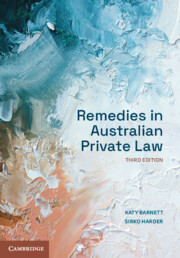Refine search
Actions for selected content:
86 results
Private Right and Public Right
-
- Journal:
- Canadian Journal of Law & Jurisprudence , First View
- Published online by Cambridge University Press:
- 24 October 2025, pp. 1-13
-
- Article
-
- You have access
- Open access
- HTML
- Export citation
Chapter 3 - The company as a separate legal entity
-
- Book:
- Contemporary Australian Corporate Law
- Published online:
- 11 September 2025
- Print publication:
- 25 September 2025, pp 80-107
-
- Chapter
- Export citation
The Subjects of Tort Law
-
- Journal:
- Canadian Journal of Law & Jurisprudence , First View
- Published online by Cambridge University Press:
- 08 September 2025, pp. 1-29
-
- Article
-
- You have access
- Open access
- HTML
- Export citation
5 - Tort Law Heterodoxy in China
-
-
- Book:
- Legal Heterodoxy in the Global South
- Published online:
- 19 June 2025
- Print publication:
- 03 July 2025, pp 149-182
-
- Chapter
-
- You have access
- Open access
- HTML
- Export citation
26 - Reasonableness from an Experimental Jurisprudence Perspective
- from Part III - Applications
-
-
- Book:
- The Cambridge Handbook of Experimental Jurisprudence
- Published online:
- 17 May 2025
- Print publication:
- 05 June 2025, pp 428-439
-
- Chapter
- Export citation
12 - Common Law, Duties, and Harms
- from Part IV - Property in Common Law and Public Law
-
- Book:
- Natural Property Rights
- Published online:
- 17 April 2025
- Print publication:
- 24 April 2025, pp 221-244
-
- Chapter
- Export citation
15 - Paying for Health Care and Private Law’s Internal Point of View
- from Part IV - How Private law Can and Cannot Control Costs
-
-
- Book:
- Health Law as Private Law
- Published online:
- 16 March 2025
- Print publication:
- 27 March 2025, pp 192-203
-
- Chapter
-
- You have access
- Open access
- HTML
- Export citation
13 - Private Law of Cryptoassets
-
- Book:
- The EU Law on Crypto-Assets
- Published online:
- 28 February 2025
- Print publication:
- 06 March 2025, pp 203-216
-
- Chapter
- Export citation
17 - Accounts of profit and disgorgement
- from Part 5 - Account of profits and other gain-based relief for wrongs
-
- Book:
- Remedies in Australian Private Law
- Published online:
- 25 October 2024
- Print publication:
- 12 November 2024, pp 462-488
-
- Chapter
- Export citation
13 - Reasonable fee awards
- from Part 4 - Remedies as vindication
-
- Book:
- Remedies in Australian Private Law
- Published online:
- 25 October 2024
- Print publication:
- 12 November 2024, pp 384-399
-
- Chapter
- Export citation
14 - Self-help remedies
- from Part 4 - Remedies as vindication
-
- Book:
- Remedies in Australian Private Law
- Published online:
- 25 October 2024
- Print publication:
- 12 November 2024, pp 400-419
-
- Chapter
- Export citation
6 - Compensation in tort
- from Part 2 - Compensation in specific contexts
-
- Book:
- Remedies in Australian Private Law
- Published online:
- 25 October 2024
- Print publication:
- 12 November 2024, pp 183-220
-
- Chapter
- Export citation
15 - Exemplary damages and aggravated damages
- from Part 4 - Remedies as vindication
-
- Book:
- Remedies in Australian Private Law
- Published online:
- 25 October 2024
- Print publication:
- 12 November 2024, pp 420-446
-
- Chapter
- Export citation
9 - AI, Consumers and Tort Law
- from Part III - Liability
-
-
- Book:
- The Cambridge Handbook of AI and Consumer Law
- Published online:
- 21 October 2024
- Print publication:
- 31 October 2024, pp 116-128
-
- Chapter
- Export citation

Remedies in Australian Private Law
-
- Published online:
- 25 October 2024
- Print publication:
- 12 November 2024
-
- Textbook
- Export citation
THE LAW GOVERNING UNITED KINGDOM GOVERNMENT TORT LIABILITY IN THE ‘WAR ON TERROR’
-
- Journal:
- International & Comparative Law Quarterly / Volume 73 / Issue 4 / October 2024
- Published online by Cambridge University Press:
- 09 December 2024, pp. 1045-1060
- Print publication:
- October 2024
-
- Article
-
- You have access
- Open access
- HTML
- Export citation
9 - Crime, Redress and Social Control
-
-
- Book:
- The Cambridge Comparative History of Ancient Law
- Published online:
- 09 May 2024
- Print publication:
- 30 May 2024, pp 446-511
-
- Chapter
- Export citation
10 - Appropriation of Personality in the Era of Deepfakes
- from Part I - Law of Obligations
-
-
- Book:
- The Cambridge Handbook of Private Law and Artificial Intelligence
- Published online:
- 21 March 2024
- Print publication:
- 28 March 2024, pp 227-249
-
- Chapter
- Export citation
6 - Tort Law and AI
- from Part I - Law of Obligations
-
-
- Book:
- The Cambridge Handbook of Private Law and Artificial Intelligence
- Published online:
- 21 March 2024
- Print publication:
- 28 March 2024, pp 135-171
-
- Chapter
- Export citation
10 - Vicarious liability and non-delegable duty
-
- Book:
- Contemporary Australian Tort Law
- Published online:
- 05 January 2024
- Print publication:
- 16 January 2024, pp 458-504
-
- Chapter
- Export citation
